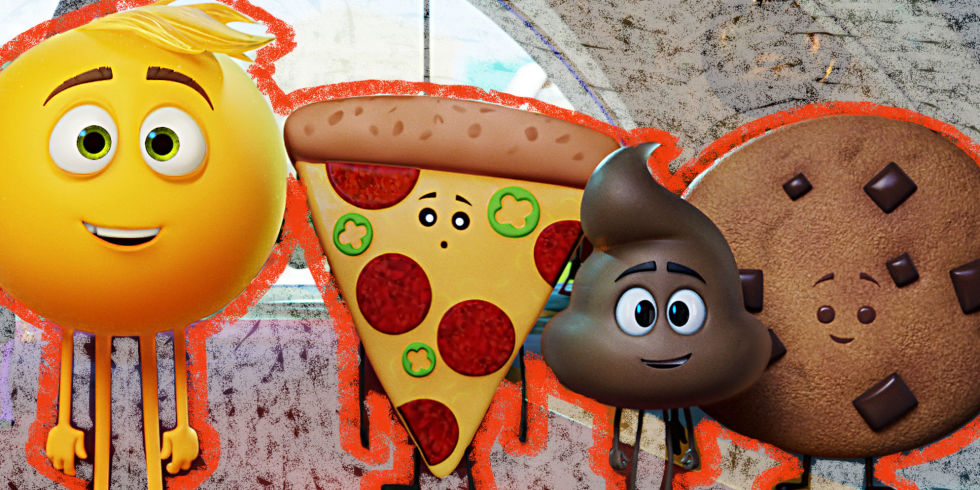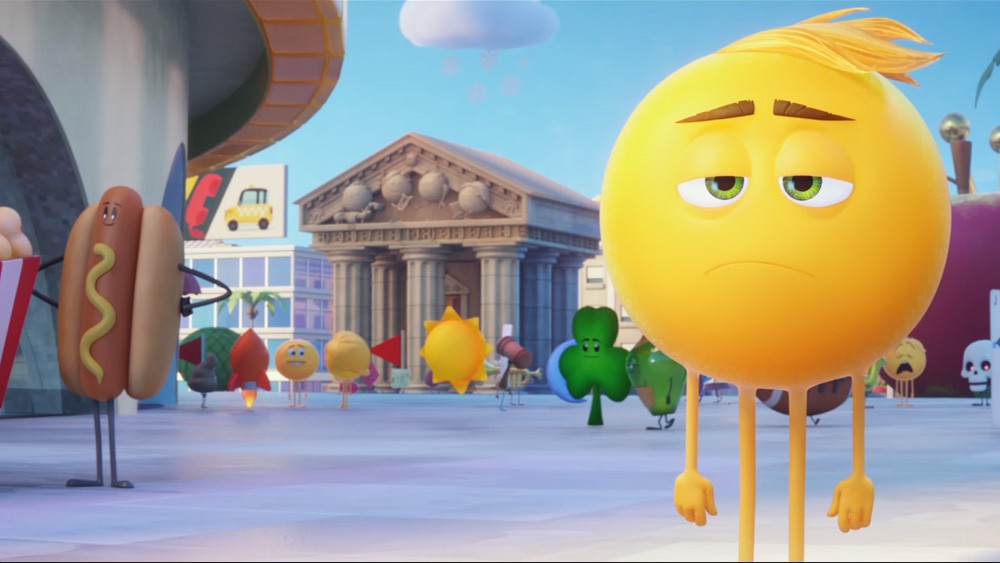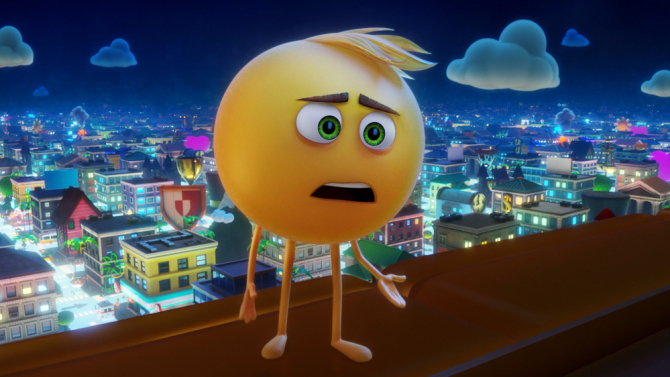
How has it lead to this? 2017 is halfway done and it has already has proven to be an underwhelming year for animation. Despite a few hits (Lego: Batman, Captain Underpants, My Life as a Zucchini), studios continue to milk these current franchises with uninspired, by-the-numbers cash cows (Despicable M3, Cars 3, and Smurfs: The Lost Village).
Shallow? Yes, but there’s no doubt that these films will tread a foot close as Sony’s The Emoji Movie which is unanimously making review headlines by critics as a possible candidate for Worst Film of 2017.
At this point, the Hollywood Film Industry will stretch what ever budget they have out of their expense for the most unoriginal and generic product to generate marquee value. Illumination Entertainment films are an example of this and The Emoji Movie is a much worse scenario.
Following the success, if not, modest success of SONY’s attempt to jump the toy-adaptation trend set by The Lego Movie (2014) with The Angry Birds Movie (2016), the studio saw the opportunity to continue this model by producing a animated film solely on Emojis.
If the difficulty of Angry Birds stretched into a feature-length film (Which, in retrospect, the film was a crude, forgettable film consisted of aimless filler and bizarre adult jokes) was a troubling sign for doom, the concept of emoticons in cyberspace feels unnecessary and purely exists to appeal to the internet trends consumed by millennial audiences.
Once the first theatrical trailer was released, The Emoji Movie immediately wore out its welcome to public, becoming the most down-voted trailer since Ghostbusters: Answer the Call (2016).
To no surprise, The Emoji Movie opened on July 28 to with an underwhelming $20 million debut weekend and an abysmal 0% on Rotten Tomatoes (8% as of today) with critics such as Peter Sobczynski of RogerEbert.com, denouncing the film as “work so completely devoid of wit, style, intelligence or basic entertainment value that it makes that movie based on the Angry Birds app seem like a pure artistic statement by comparison.” The Emoji Movie further signifies a cold, soulless, corporate embodiment of everything wrong with animated films and SONY as a once-prominent film company.
1. Product Placement

SONY as a massive media conglomerate is known for their state-of-the-art home theater, video gaming and cellular technology products. However, SONY cannot avoid plastering their brand products and then some in their recent films.
Like the films (The Amazing Spiderman, Ghostbusters: Answer the Call, and the live-action Smurfs films) meddled under SONY’s hands, The Emoji Movie is no exception as it is one commercial for Smartphone apps disguised as a 90-minute kids movie.
It’s sheer desperation for SONY to have a hit film that the actual movie convinces the audience of how important Emojis and Smartphones are to contemporary society that it blatantly shoves YouTube, Facebook, Twitter, Spotify, Instagram, etc. in adverts rather than sequences.
To make matters worse, the story serves to advertise these apps and progress the plot from A to B without any thoughtful commentary; at some point, the lead characters stumble into Candy Crush and Just Dance to reach their destination at Dropbox. To build up the climax, a character summons a bird resembling the Twitter Logo in a race against time. These are all written into the script and anyone can spot the intentions behind this decision.
It’s cynical and lazy filmmaking that it probably pardons Power Rangers (2017) for its Krispy Kreme product placement. As if a film designed to sell products than a story feels cynical enough, The Emoji Movie tries to sell itself with an obnoxious form of dance as the next hit meme called “The Emoji Pop” which provided one of the most cringeworthy scenes of this year.
It’s similar to Norm of the North’s (2016) attempt to market the “Arctic Shuffle” in its most poor execution. The product placement in The Emoji Movie solidifies SONY’s shallow business model seen in their previous filmography served only by the story and providing visual references for one of the film’s other mundane aspects.
2. The Humor

This is a faint praise for potential, but a film like The Emoji Movie could have been a potentially interesting comedy that can appeal to mature audiences in the vein of Sausage Party.
While Sausage Party tackled religious politics and the belief system underneath its raunchy humor, The Emoji Movie would have provided an opportunity to comment and satirize social media, internet culture and the collective cynicism encompassing it. Instead, the producers and SONY decide to make The Emoji Movie to aim at a family audience to sell ticket sales easier.
As a result, the comedy and the voice actors hired for this material fall embarrassingly flat and bomb at every attempt. The humor is presented at the surface with obvious sight gags and cheap jokes reserved for a canceled sitcom in its debut season. To pander to the lowest common denominator, the jokes consisted of potty jokes and puns with no substance or a sense of self-awareness for that matter.
Did anybody know Patrick Stewart plays Poop? Oh, don’t wash your hands, kids! There are also weird adult innuendos scattered in the film, for example, when our characters reach a shady tavern in the Wallpaper, one of them delivers a line of dialogue hints at internet porn.
This is the caliber of humor we’re talking here. Considering most of the voice cast are famous comedians, the writing for these characters holds no charm, enthusiasm and worst of all, they are unfunny. Another faint praise given here is Steven Wright’s performance as a Meh Emoji named Mel and while his character presented as a running joke that wears thin for the film’s duration, sometimes, deadpan, dry humor gives a chuckle or two for Wright’s delivery.
3. The Plot

The Emoji Movie is such a poorly written film that it convinces its target audience the Smartphone is the most important invention to mankind. Also, Emojis are the most essential form of communication according to film’s logic and it’s right in the first 5 minutes.
What’s already insulting about The Emoji Movie is that it shamelessly rips off The Lego Movie, Wreck it Ralph and Inside-Out and blends them together in a nauseating concoction. As a result, the film provides an abhorrently unmemorable plot with unfunny characters and the situations presented to sell to its demographic.
The “plot” follows a ‘Meh’ Emoji named Gene (T.J. Miller) who is conflicted of expressing other emotions to other Emojis and his parents, Mel and Mary Meh (Steven Wright & Jennifer Coolidge, respectively) that his community ostracizes him for his lack of conformity even though this is a world where no one questions the existence of a anthropomorphic piece of excrement.
Did anyone know Patrick Stewart plays Poop? The problem with this premise is not only it heavily derives from the three films, the plot is incredibly thin on the logic, rules and arcs of these characters the film presents.
After the film’s “inciting incident,” Gene is labeled as a “malfunction” and is pursued by Smiler (Maya Rudolph) and her army of bots to delete him permanently. So, Gene has to change his function back to ‘Meh’ at the Dropbox with the help of outcast Emojis Hi-5 (James Corden) and Jailbreak (Anna Faris).
Aside from the terrible humor, the plot tries to preach a message of non-conformity and also, showing emotion, in which, Inside Out executed better. Therefore, the moral is if you’re afraid to show emotion, remain apathetic and conform in society which is a hollow message to kids. And by the end, Gene does not learn a meaningful lesson in his journey.
This is also evident with the arc of Jailbreak where, spoiler, she is a former Princess Emoji turned gothic, self-independent woman that ultimately loses purpose when she has to conform to her roots in order to save the protagonist. An action that has no potential payoff. Even the romance between Jailbreak and Gene is shoved in for conflict’s sake with no chemistry, charm or any reason to care about their relationship.
The events that take place with these characters surround another subplot, in which their user, a teenage boy named Alex (Jake T. Austin) has difficulty choosing an Emoji to woo his school crush because that’s high priority.
The situations that occur within the world of the Smartphone causes his apps to sound off like ringtones which would not happen in reality, but again, it’s a cartoon. And so, the breaking point is that Alex will delete his phone which will eradicate the Emojis inhabiting his device.
Overall, the film mainly sticks to the generic animated film tropes we have seen in countless other films: (1) Characters form an unlikely relationship and they have to work together to reach a certain goal, (2) there’s a comic relief sidekick who stumbles across the film, (3) there’s a journey for adventure, (4) occasional potty humor for more cheap laughs and (5) finally, the film ends in the most cliché obnoxious trope: a dance number.
Because of its desperate attempt to milk those films’ successes, the plot never explains, fleshes out or properly establish the world building in the most visual way understands to comprehend due to the animation at work here.